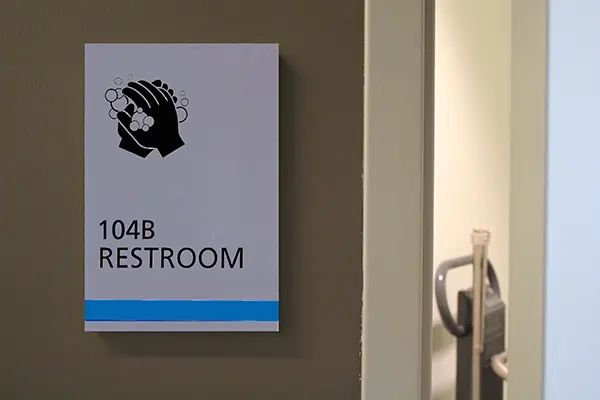New Signage, Restroom Policy Create More Inclusive Environment

04/22/2016
By Ed Brennen
With an eye toward creating an even more inclusive campus culture, the university has designated 40 single-person restrooms as “gender-neutral” and approved a new bathroom policy that strives to meet the diverse needs of all students, faculty and staff.
This spring, 40 single-person restrooms in 21 academic, administrative and residential buildings across campus will receive new signage that simply identifies them as “Restroom” (in English and Braille) with an image of washing hands. All of the restrooms that are being re-designated were previously a mix of men’s, women’s, unisex and family facilities.
According to Clara Orlando, director of the university’s Office of Equal Opportunity and Outreach, it’s a relatively simple change that helps address an important issue that is gaining attention in schools and workplaces across the country.
“The goal of the university is to develop a climate where everyone feels respected, where everyone feels that they’re part of the community and that they are comfortable,” Orlando says. “And there are members of the community, both from the student body and faculty and staff, who have made this request.”
In addition to the signage change, the university has approved a new policy regarding restrooms that states in part, “Members of the UMass Lowell community and campus guests may use the bathrooms that correspond to their sex or gender identity or bathrooms designated as gender-neutral.”
“There are members of the community who would like to be able to use facilities in which they feel comfortable, and this allows them to do that,” Orlando says.
According to a recent report, more than 150 colleges and universities across the United States have instituted gender-neutral facilities. Even the White House added one last year.
Before university officials could designate restrooms as gender-neutral, they needed to apply for a waiver from the Board of State Examiners of Plumbers and Gas Fitters, which requires public buildings to have a specified number of male and female facilities based on the population of those it serves.
Peter Brigham, the university’s assistant director of planning, urban design and transportation, says the state already recognized “unisex” bathrooms, identified with a sign featuring both a male and female figure.
“But we were trying to get away from that since it didn’t meet the needs of the community,” says Brigham, who believes the new signs’ hand-washing imagery is something that everyone will understand. “The whole point is not to have categories — that this is a restroom for everybody.”
